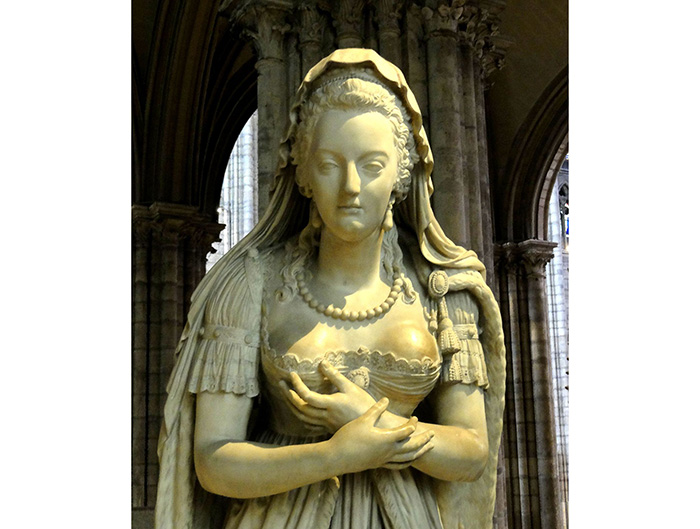By P.poschadel — Commons.wikimedia.org
French scientists have deciphered edited love letters of Marie Antoinette, the Associated Press reported.
Scholars believe that they were personally edited by her alleged lover, the Swedish Count Axel von Fersen. They were sent to her close friend and alleged lover, the Swedish Count Axel von Fersen. The content of some of the letters was changed with darker ink than the original, and the purpose was most likely to soften the language of love.
Scientists are applying a new method to decipher the original text by dividing the chemical composition of the inks used in writing historical documents.
In this way, they arrive at the original words written by Marie-Antoinette, and even manage to identify the person who deleted them – it was Ferzen himself.
The two corresponded for two years after the French Revolution in 1789. At that time, the Queen and King Louis XVI were living under surveillance at the Tuileries Palace and had just failed in an attempt to escape from house arrest.
In eight of the 15 analyzed letters, sufficient differences in the chemical composition of the inks were found – in the ratio between iron, copper and other elements, so that scientists could reconstruct the original text.
Researchers are pleased that the new technology allows them not only to reveal the edited words, but also the identity of the one who changed them. They are adamant that Ferzen made the corrections, because the composition of the ink from his letters is similar to that with which the corrections were made. The motives for the edits remain unclear.
Deleted words such as “crazy” and “beloved” do not change the general meaning of the correspondence.
“People used very colorful language at the time – but these are really strong and intimate words. We know from this text that there was a love affair,” said Anne Michelin of the Sorbonne, who co-authored the study. Science Advanceis.
Marie-Antoinette and Ferzen met in France when they were both 18 years old. They kept in touch until her death. He never married.
Photo: Statue of Marie Antoinette in the Basilica of Saint-Denis near Paris (iStock by Getty Images)














 English
English French
French Spanish
Spanish German
German Dutch
Dutch Italian
Italian Danish
Danish Portuguese
Portuguese Greek
Greek Russian
Russian Swedish
Swedish Bulgarian
Bulgarian Hungarian
Hungarian Catalan
Catalan Ukrainian
Ukrainian Polish
Polish Basque
Basque Chinese (Simplified)
Chinese (Simplified) Japanese
Japanese Hebrew
Hebrew Arabic
Arabic Swahili
Swahili Amharic
Amharic Irish
Irish Afrikaans
Afrikaans Albanian
Albanian Armenian
Armenian Azerbaijani
Azerbaijani Belarusian
Belarusian Bengali
Bengali Bosnian
Bosnian Cebuano
Cebuano Chichewa
Chichewa Chinese (Traditional)
Chinese (Traditional) Corsican
Corsican Croatian
Croatian Czech
Czech Esperanto
Esperanto Estonian
Estonian Filipino
Filipino Finnish
Finnish Frisian
Frisian Galician
Galician Georgian
Georgian Gujarati
Gujarati Haitian Creole
Haitian Creole Hausa
Hausa Hawaiian
Hawaiian Hindi
Hindi Hmong
Hmong Icelandic
Icelandic Igbo
Igbo Indonesian
Indonesian Javanese
Javanese Kannada
Kannada Kazakh
Kazakh Khmer
Khmer Korean
Korean Kurdish (Kurmanji)
Kurdish (Kurmanji) Kyrgyz
Kyrgyz Lao
Lao Latin
Latin Latvian
Latvian Lithuanian
Lithuanian Luxembourgish
Luxembourgish Macedonian
Macedonian Malagasy
Malagasy Malay
Malay Malayalam
Malayalam Maltese
Maltese Maori
Maori Marathi
Marathi Mongolian
Mongolian Myanmar (Burmese)
Myanmar (Burmese) Nepali
Nepali Norwegian
Norwegian Pashto
Pashto Persian
Persian Punjabi
Punjabi Romanian
Romanian Samoan
Samoan Scottish Gaelic
Scottish Gaelic Serbian
Serbian Sesotho
Sesotho Shona
Shona Sindhi
Sindhi Sinhala
Sinhala Slovak
Slovak Slovenian
Slovenian Somali
Somali Sundanese
Sundanese Tajik
Tajik Tamil
Tamil Telugu
Telugu Thai
Thai Turkish
Turkish Urdu
Urdu Uzbek
Uzbek Vietnamese
Vietnamese Welsh
Welsh Xhosa
Xhosa Yiddish
Yiddish Yoruba
Yoruba Zulu
Zulu